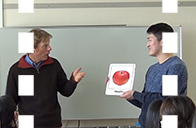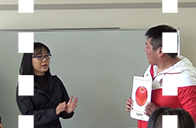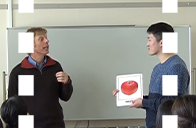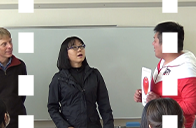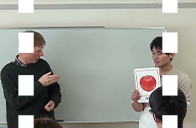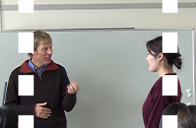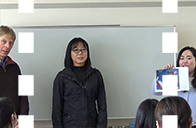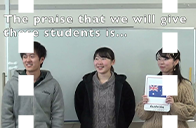5教室談話Classroom Discourse
本セクションは,教室談話の推進を目的として作成されています。まず,修正フィードバックの5事例を提示しています。これらのビデオクリップは,Lysterと Rantaのフィードバックに関する先行研究に基づいて,分類されています。全ての事例が,日本の小学校における英語学習と,完全に一致するとは言えない場合があることを,ご了承下さい。また,後半のビデオクリップでは,文型重視英語と内容重視英語の4事例を提示しています。日本の英語教育においては,コミュニケーションが重視されていること踏まえ,内容重視英語を意識した指導を奨励しています。
The purpose of this section is to raise awareness of the kind of discourse we are promoting in the classroom. The “feedback” clips present categories of feedback identified in Lyster and Ranta (1997). Not all of the examples are appropriate in Japanese elementary schools, as you can see. We also wanted to highlight the distinction between form focus and meaning focus. Since “communication” is the dominant theme throughout Japanese English education, we always encourage teachers to strive for more meaning focus in the classroom.
Ref. Lyster, R., and Ranta, L. (1997). Corrective feedback and learners uptake: negotiation of form in communicative classrooms. Studies in Second Language Acquisition, 19, 37 ? 61.
フィードバック:明確化要求Feedback: Clarification request
この事例は,児童の言語表現の間違いに気づかせることを目的としています。児童が話した内容を重視しますが,教師からの指摘で,自らの間違いに気づかせます。
This pushes students to think about their mistake, while maintaining focus on meaning but it takes a little more thought from teachers.
フィードバック:明示的訂正Feedback: Explicit correction
教師は,児童の言語表現の間違いを訂正することにのみ, 焦点をあてています。この方法は,多くの状況で適切ではないかもしれません。
The teacher highlights the error and tells students the correct form. This may not be appropriate in many situations.
フィードバック:メタ言語Feedback: Metalinguistic
教師が,文法にのみ焦点をあてて一方的に説明をすることは,殆どの教室談話において,適切とは思われません。
Here, teachers explain the “rule”. In many situations this may not be appropriate.
フィードバック:引き出し,誘引Feedback: Elicitation
教師は,児童に,間違いの訂正を間接的に促します。
The teacher asks the students a question to try to elicit the correct form after a mistake.
フィードバック:リキャストFeedback: Recast
教師が, 正しい文法表現を用いて,児童が言ったことを言い直します。この談話は,児童が言った内容は維持しながら,正しい言語表現に気づかせることを目的としています。
Teachers re-phrase the student’s utterance using the correct grammar. The pace of discourse is not interrupted and focus remains on meaning but do students notice the correction?
フィードバック:反復Feedback: repetition
ここでは,教師が子どもたちに気付かせるために,まちがいに重点をおいて繰り返しをさせています。
Here, the teacher repeats the error with emphasis, to draw students’ attention to it.
文型重視例1Focus on form 1
教師が,児童の話している内容を全く聞いていない極端な例です。
This example is an exaggeration. The teacher is not listening to the content of what the student is saying at all.
文型重視例2Focus on form 2
教室でしばしば見られる談話の事例です。悪くはないのですが,もう少し内容を重視したほめ方を取り入れた談話に切り替えることが推奨されます。
We can see this kind of discourse in the classroom often. It’s not bad, but I would encourage teachers to try to shift the focus a little more toward meaning.
内容重視例1Focus on meaning 1
ここでの教師の対応は,(前例Focus on form 1 文型重視例1に比べると)かなり適切です。
This would be probably be a more appropriate response.
内容重視例2Focus on meaning 2
この談話は話題が発展し過ぎてはいますが,自然な会話で見られるコミュニケーションを反映しています。
The discourse here is a little more ‘messy’ but this reflects the true nature of communication.
表現が言えた時に褒めるForm-based praise
子どもを褒めるのはよいことです。しかし発話の内容に焦点をあててしっかり褒めることがより意味のあることです。
Praise is nice, but we think more specific praise based on the content is more meaningful.
一般的な褒め言葉Very General praise
子どもを褒めることはよく行われていますが,具体的なコメントを伝えることがより意味のあることです。
Here the praise is very general, but again, maybe specific comments are more meaningful.
